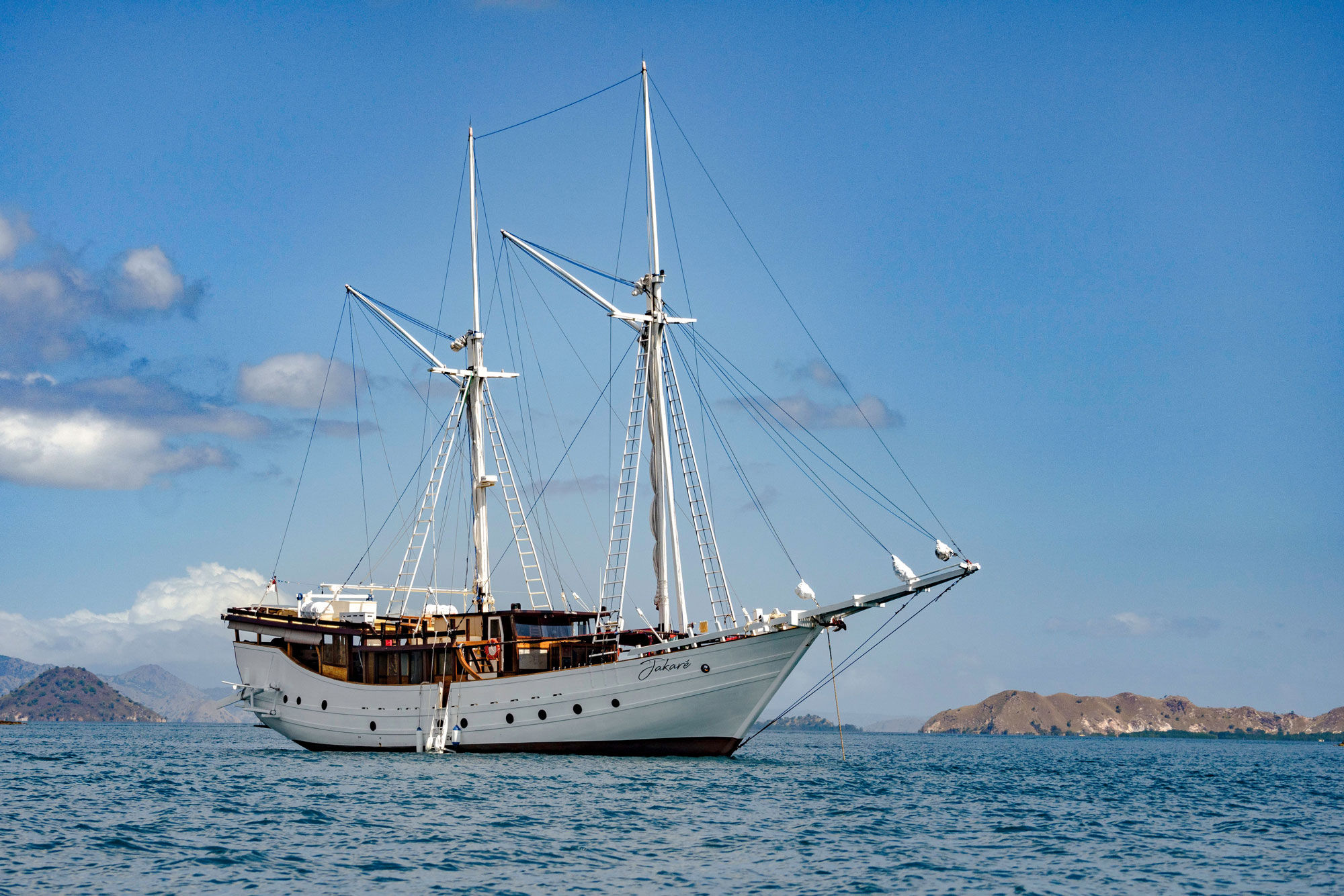日程安排
行程范例
DAY 1: Labuan Bajo & Pulau Kaaba
下午在Labuan Bajo机场接客人,然后在Labuan Bajo港口登上Jakare。如果时间允许,航行至Pulau Sebayur Kecil进行一次适应性潜水,然后航行至Pulau Kaaba / Rinca于下午结束时观看蝙蝠。在Pulau Kaaba抛锚过夜。
活动:将提供欢迎饮品和零食,同时巡航总监将向客人简要介绍安全事宜、船上安排和整体行程,并介绍船员。随后将为客人展示他们的舱房,让他们安顿、放松,并准备好开始巡航。
如果时间允许,Jakare将航行向Pulau Sebayur。此段航行通常是休息和潜水简报(检查认证和潜水装备)的好时机。
- 潜水 1: 这次潜水是Sebayur Kecil的适应性潜水,简单易行,用于测试设备、刷新潜水技能并熟悉设施。
随后Jakare将向南航行至Pulau Kaaba(10海里),并在小岛附近抛锚。观看蝙蝠活动将在日落时开始,持续几个小时。客人若天空晴朗,可以在甲板上观星。
过夜:在同一Pulau Kaaba位置抛锚。
DAY 2: Pulau Rinca, Komodo Dragons and Pulau Padar
概览:清晨,航行至Pulau Kambing。在Wainilu潜水,随后前往Loh Buaya / Rinca参观科莫多巨蜥(Varanus Komodoensis)。航行至Pulau Tengah并在那里潜水。然后航行至Pulau Mawan,并在那里潜水。接着前往Padar并在Pulau Padar过夜。
活动:Jakare将于清晨航行至附近的Pulau Kambing,以在大约7:30到达泊区。
- 潜水 2: Wainilu潜水,这是科莫多岛最好的泥潜之一,位于红树林区域。
客人将在船上享用早餐,然后前往参观科莫多巨蜥。从船舶到Loh Buaya岸边的交通将通过小艇完成,到了码头后,客人将由护林员欢迎并带到国家公园办公室,护林员会给我们说明。在护林员的引导下,令人惊叹的Rinca稀树草原徒步游览将根据选择的路线持续30分钟到2小时。科莫多龙和野生动植物如野猪或鹿常被观察到在护林员站附近和野外。随后Jakare将航行至Pulau Tengah进行当天的第二次潜水。
- 潜水 3: Pulau Tengah潜水:这是一项动态潜水,位于科莫多主要水流中间的顶点。墙壁上布满了软硬珊瑚,根据条件,可看到大群的鱼。海龟、鲨鱼、鲹鱼和其他大型鱼类在水流边缘活动。
- 潜水 4: 随后Jakare将航行至科莫多中心的Pulau Mawan,在这里较浅水域通常会看到魔鬼鱼、鲨鱼和海龟。潜水地点还拥有一个美丽的珊瑚花园。
Jakare随后将顺流航行至Pulau Padar。于Padar抛锚和过夜。
DAY 3: Pulau Padar (Central-South Komodo)
概览:早晨在Pulau Padar徒步,然后潜水Pillarsteen、the Three Sisters和secret garden。随后向南航行至Nusa Kode(Rinca南部)。日落前到达,抛锚过夜于Nusa Kode。
活动:早晨醒来,攀登Padar欣赏科莫多群岛的壮丽日出。返回Jakare,享用丰盛早餐,跳入水中降温。
- 潜水 5: Tree Sisters潜水:根据时间安排,这次潜水可能有挑战性。位于Padar东南,这个潜点由3个主要的大潜伏石块组成,水深从3米到30米不等。以海兔和多样性生物而闻名,也有大批黄蓝袍鱼、珊瑚鱼和一些大型鱼类。
- 潜水 6: Pilarsteen潜水:一面漂亮的墙壁上覆盖着色彩鲜艳的珊瑚和海绵,满是海洋生物,如大群的烽火鱼。地貌非常有趣,有不同深度的洞穴和水道。
- 潜水 7: Secret Garden潜水:位于海湾的另一侧,这个地方拥有美丽的珊瑚和丰富的海洋生物。通常可以看到魔鬼鱼或蝠鲼。
潜水后,Jakare将离开前往科莫多最受欢迎的景点之一:Pantai Merah或粉红海滩。参观美丽的海滩,浮潜和潜水。客人可以在海滩上欣赏日落,然后返回Jakare享用晚餐。在Pantai Merah附近抛锚过夜。
- (选项) 潜水 8: 夜潜 - Pantai Merah
DAY 4: Komodo Central
概览:早晨醒来并航行至科莫多中心,潜水Karang Makassar,航行并潜水Batu Bolong,Pulau Tatawa,然后航行至Gili Lawa过夜。
活动:经过一个清晨的出发,客人将在前往科莫多中心的途中享用早餐。Jakare将在Pulau Siabah或附近抛锚或停泊。客人将乘坐小艇前往Karang Makassar,著名的魔鬼鱼清洁和觅食站。
- 潜水 9: Karang Makassar潜水:通过小艇进入。这是一个丰厚的浮潜和潜水点,魔鬼鱼或鹰鳐可能会从水面上被发现。该地点水深8-15米,魔鬼鱼来自各地,被小鱼清理并从丰富的营养水中觅食。这些雄伟鱼类提供了一个独特的景象,不容错过。在Jakare上好好休息后,Jakare将航行至Batu Bolong,我们在科莫多最佳的潜水点之一。
- 潜水 10: Batu Bolong潜水:Batu Bolong是信道中的一顶尖露出的顶点,在这个动态的珊瑚礁上提供了水流潜水。软硬珊瑚色彩鲜艳且健康,所有食物链都可以公开展示,从于丰富的水中觅食的珊瑚鱼到包括黑鳍和白鳍鲨以及巨型鲹鱼的大型鱼类。黄鳍梭鱼、黄鲷鱼和银鲹的鱼群以及狗牙金枪鱼都非常常见。绝对不能错过。Pulau Tatawa可以作为额外潜水提议。
- 潜水 11: Tatawa Besar潜水:一个美妙的漂流潜水,从Tatawa Besar岛的北端开始,两侧均有。通常可以看到大量的硬珊瑚、珊瑚鱼和烽火鱼群。
- (选项)潜水 11: 或者Tetawa Kecil潜水:依赖于潮汐的更高阶潜水。岛屿的西侧是潜水的最佳选择,包含巨石和洞穴,海扇植物居多。可以观察到成群的鲷鱼、甜唇鱼、鲹鱼,珊瑚非常健康美丽。
随后Jakare将向Pulau Gili Lawa航行,并在途中,如果稍好运气,客人可在Pulau Komodo的海滩或草原上看到野猪或当地鹿。Jakare将在Gili Lawa南部的一个宁静海湾中泊位或抛锚。
DAY 5: Pulau Gili Lawa (Komodo North)
概览:在Golden Passage潜水,然后向北航行并在Crystal Rock和Castel Rock潜水。随后Jakare将向南航行,在东海岸,靠近Coldron Dive地潜的宁静海湾中停泊。
活动:
- 潜水 12: 在Golden Passage潜水:一个水流潜水,位于Gili Lawa岛和科莫多岛之间,将提供美丽且健康的软硬珊瑚以及丰富的海洋生物,包括海龟、甜唇鱼和在富裕快速流动水域中捕猎的鲹鱼鱼群。
进行首次潜水后,Jakare将航行北上,在Gili Lawa Laut北部停泊,面向Crystal Beach。
- 潜水 13: Crystal Rock潜水:因其通常的清澈水域命名,这个潜点是一个直接面向水流的暴露顶点,吸引很多海洋生物,包括珊瑚鱼,以及会吸引__型的大型鱼类,如礁鲨、灰鲨和巨型鲹鱼。潜点足够大,以容纳所有潜水水平,也可在不那么暴露的温和坡度珊瑚中找到很多小生物。
- 潜水 14: Castel Rock潜水:Castel Rock是科莫多的标志性潜点之一,与Crystal Rock类型相似,尽管顶点较小,因此潜水有时更具技术性、流流较强,海洋生命非常丰富,包括成群的鲹鱼、烽火鱼、鲷鱼、礁鲨、巨型鲹鱼、海龟以及非常健康的珊瑚。
随后Jakare将离开其北部位置,为寻找一个在Gili Lawa东岸上的宁静海湾中的锚地,同时留出时间让客人在船上休息,并可能探索岛屿或发现Jakare附近的珊瑚礁使用皮划艇和SUP。在Gili Lawa过夜。
DAY 6: Pulau Gili Lawa (Komodo North)
概览:潜水Coldron、Aquarium和Golden Passage反向潜水。夜间过夜于Gili Lawa。
活动:提出在Gili Lawa草原进行一个清晨的徒步(在徒步允许的条件下)。客人返回到Jakare,享用早餐,准备潜入shotgun passage和Aquarium。
- 潜水 16: Coldron潜水:科莫多最壮观的潜水之一。这个潜点是Gili Lawa Darat和Gili Lawa Laut之间的一个通道,创造了有趣的地形和强流,吸引了大量的海洋生物,并在通道的两侧有惊人的硬珊瑚花园。可以看到鹰鳐和魔鬼鱼,也有很多大型鱼类,如鲹鱼、金枪鱼等。Coldron也是像青蛙鱼和海兔这样的微小神秘生物的家园。
- 潜水 17: Aquarium潜水:一个简单的潜水点,享受漂亮的珊瑚花园,并可能在去Coldron的路上看到魔鬼鱼或其他大型鱼类。
- 潜水 18: Golden passage潜水(反向): 与上面相似的潜点,但是反向进行。漂流/水流潜水,提供两侧壮观的珊瑚花园。在宁静的Gili Lawa湾过夜。
DAY 7: Pulau Siaba - Labuan Bajo
概览:Jakare将一早启航,向科莫多中部的Pulau Siaba新的潜点航行。然后航行返回Labuan Bajo。
活动:Jakare将早
早开始,依据客人的选择向北或南航行。在航行途中客人可以享用早餐。
- 潜水 19: Siaba Besar潜水:Siaba Besar 的巨大而健康的硬珊瑚礁位于一个平静的海湾中,是海龟、鳐鱼和众多珊瑚鱼的栖息地。珊瑚周围的沙地是一个令人惊叹的微距潜水点,有各种青蛙鱼、墨鱼和海兔。
- 潜水 20: Siaba Kecil潜水:Siaba Kecil是一个非常好的漂流潜水,适合高级潜水员。它可以在退潮时(右侧珊瑚礁)或涨潮时(左侧珊瑚礁)进行。珊瑚礁内有丰富的硬珊瑚,包括漂亮的海扇,并且在蓝色区域中经常能看到大型鱼类(鲹鱼、鲨鱼)。
上午结束时,Jakare将向东航行返回Labuan Bajo。
在返回Labuan Bajo的途中,客人将有时间填写他们的潜水日志(如果还没有完成)、由潜水教练/潜水长盖章、并交换从这段美好时光中获得的地址和照片。在离开船舶并前往机场或酒店之前,当Jakare船上将组织一个小仪式和与船员道别的活动。
(*) 行程描述由船舶运营商提供
海洋生物:至少75%的珊瑚物种可以在Raja Ampat找到,潜水员可以期待从软珊瑚和海扇到硬珊瑚、海草床、红树林、浅礁、深落差,洞穴,黑沙和白沙的多种地貌。巨型魔鬼鱼(manta rays)、海龟、鲨鱼、墨鱼(cuttlefish)、管鱼(pipefish)、各种海马(seahorse)和大量的礁鱼群是常态,还有奇特的鲨鱼和肩章鲨鱼(epaulet sharks)也居住在这些水域中。
最后一潜将在行程倒数第二天进行。建议潜水员在最后一潜之后等待24小时再进行飞行。
样本行程和地图仅供说明示例。确切的航线和访问的地点可能基于当地法规、客人经历、天气和物流变动,并由船长酌情决定。
每天的节目将由客人每晚为第二天介绍、讨论并确认。
 微信扫码添加人工客服
微信扫码添加人工客服



